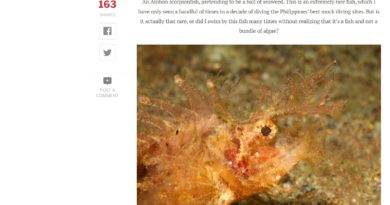Dauin Nudibranchs – Questions
Next month I am celebrating an anniversary: I will have been in the Philippines for 7 years. Good times, great friends, lots of dives! Given 7 more years I might even learn to calm down when facing the traffic around Dumaguete.
I’m diving quite regularly these days, despite the ongoing semester at Silliman University. These days more nudibranchs (sea slugs) seem to be populating the reefs and muck diving sites of Dauin. While my main interest are small fishes, especially gobies, I enjoy looking at, filming and photographing nudibranchs.
I have a few questions about nudibranch biology, to which I genuinely don’t have any good answers, which occurred to me during my Dauin diving. But let’s look at a nudi video first…
Check out this video of nudibranchs which I sped up 4 times to 6 times – the otherwise very placid looking animals look like Speedy Gonzales after my editing efforts:
Where Are They Most Of The Time?
I often go for weeks without seeing many nudibranchs other than a had full of the common species belonging to the genera of Phyllidia and Phyllidiella. Often I don’t see much of the rarer species for months, until there is a bloom – in June I saw a lot of Jorunna funebris, which I now haven’t seen for a while, again. Some species I don’t see for years, until I encounter several individuals on one dive.
Where are they the rest of the time? I assume they exist as larvae, and as juveniles to small too small to (typically) find, even for the eyes of a skilled critter-spotter. But why these irregular cycles? The water temperature in Dauin doesn’t fluctuate very much, and while the winds and waves change between Habagat (South-West winds) and Amihan (North-East winds), but this doesn’t change the physical conditions below about 10 meters much, according to my impression. Currents at these depths are not much different, and without having done any analytic water chemistry, I don’t have the impression that nutrient levels are so different (algal growth doesn’t seem different). In any case, the cycles of nudibranch occurrence don’t sync with the Amihan/Habagat cycles. So either I am missing some important variation in physical ocean parameters which drives these cycles, or the population dynamics of the nudibranchs are governed by some higher-order cyclic (not plainly regular, annual) population dynamics.
How do reproductively active populations persist with such low population densities? When I see 3 small, slow-moving nudis of one species on a dive covering 200+ meters, how do these animals find mates? Even if they find each other, is the population large enough to maintain a reasonable amount of genetic diversity? For mammals, low genetic diversity can be devastating, but is this also the case for nudibranchs?
A part of the solution for these questions is, of course, sampling bias (under-sampling). There will be more nudibranchs, both species as well as individuals than I see. But, likely, not an order of magnitude more. During the aforementioned dive covering 200 meters or more of coastline, there might be 6 or 15 nudis, while I spot 3 of them, but likely not 300; This is more so the case when dealing with larger species (Jorunna funebris can grow to ~10 cm); The conundrum remains.
This is a Flickr album with all my still photographs of Dauin nudibranchs, and a few non-nudibranch sea slugs.
More Nudibranch Videos
Also, please check out my friend Justin’s YouTube project page for a Dauin-wide nudibranch census.
Best Fishes & Till Soon,
Klaus


